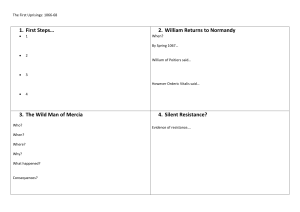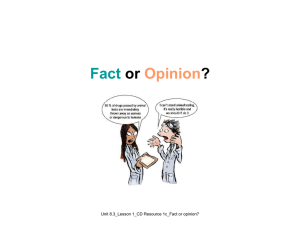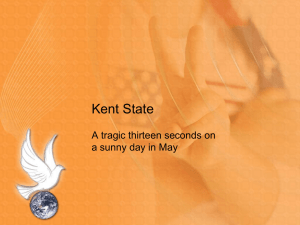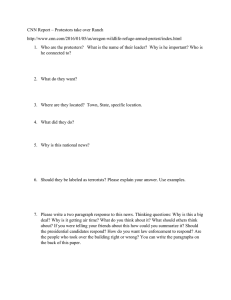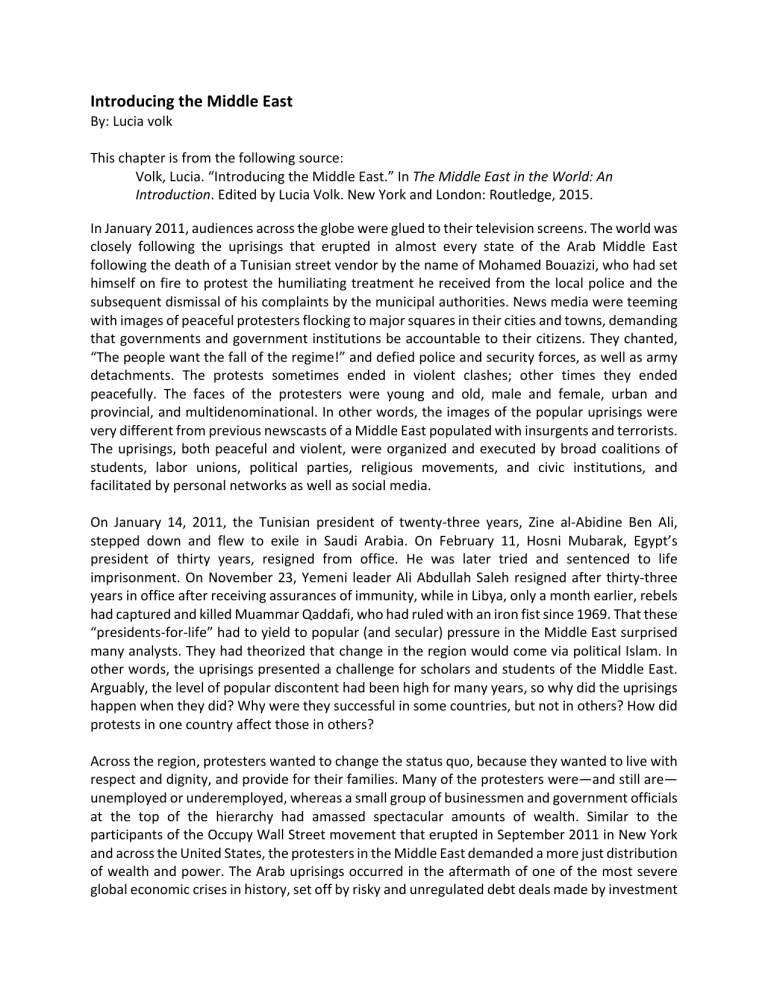
Introducing the Middle East By: Lucia volk This chapter is from the following source: Volk, Lucia. “Introducing the Middle East.” In The Middle East in the World: An Introduction. Edited by Lucia Volk. New York and London: Routledge, 2015. In January 2011, audiences across the globe were glued to their television screens. The world was closely following the uprisings that erupted in almost every state of the Arab Middle East following the death of a Tunisian street vendor by the name of Mohamed Bouazizi, who had set himself on fire to protest the humiliating treatment he received from the local police and the subsequent dismissal of his complaints by the municipal authorities. News media were teeming with images of peaceful protesters flocking to major squares in their cities and towns, demanding that governments and government institutions be accountable to their citizens. They chanted, “The people want the fall of the regime!” and defied police and security forces, as well as army detachments. The protests sometimes ended in violent clashes; other times they ended peacefully. The faces of the protesters were young and old, male and female, urban and provincial, and multidenominational. In other words, the images of the popular uprisings were very different from previous newscasts of a Middle East populated with insurgents and terrorists. The uprisings, both peaceful and violent, were organized and executed by broad coalitions of students, labor unions, political parties, religious movements, and civic institutions, and facilitated by personal networks as well as social media. On January 14, 2011, the Tunisian president of twenty-­‐three years, Zine al-­‐Abidine Ben Ali, stepped down and flew to exile in Saudi Arabia. On February 11, Hosni Mubarak, Egypt’s president of thirty years, resigned from office. He was later tried and sentenced to life imprisonment. On November 23, Yemeni leader Ali Abdullah Saleh resigned after thirty-­‐three years in office after receiving assurances of immunity, while in Libya, only a month earlier, rebels had captured and killed Muammar Qaddafi, who had ruled with an iron fist since 1969. That these “presidents-­‐for-­‐life” had to yield to popular (and secular) pressure in the Middle East surprised many analysts. They had theorized that change in the region would come via political Islam. In other words, the uprisings presented a challenge for scholars and students of the Middle East. Arguably, the level of popular discontent had been high for many years, so why did the uprisings happen when they did? Why were they successful in some countries, but not in others? How did protests in one country affect those in others? Across the region, protesters wanted to change the status quo, because they wanted to live with respect and dignity, and provide for their families. Many of the protesters were—and still are— unemployed or underemployed, whereas a small group of businessmen and government officials at the top of the hierarchy had amassed spectacular amounts of wealth. Similar to the participants of the Occupy Wall Street movement that erupted in September 2011 in New York and across the United States, the protesters in the Middle East demanded a more just distribution of wealth and power. The Arab uprisings occurred in the aftermath of one of the most severe global economic crises in history, set off by risky and unregulated debt deals made by investment and commercial banks. Domestic economies contracted around the world, stifling growth and opportunity. Young people in the Middle East, as elsewhere, were particularly affected. Protesters in Egypt held up signs displaying solidarity with protesters in the United States, or vice versa. Student activists connected globally via Facebook, Twitter, and YouTube, circumventing traditional, state or privately owned news media that often under-­‐ or misreported events. Young women, in particular, emerged as protagonists during the demonstrations. Via a YouTube video that went viral, the Egyptian student, Asmaa Mahfouz, asked her fellow Egyptians to come meet her in Cairo’s Tahrir Square to demonstrate against the government: “If we still have honor and want to live in dignity, we will go down on January 25, we’ll go down and demand our rights, our fundamental human rights.” Her voice carried great urgency and conviction. First thousands, then hundreds of thousands of protesters congregated on Tahrir Square on and after January 25, in a movement that would topple the president. In Yemen, another woman became the public face of the uprising by speaking out against the corruption and dysfunction of the government of President Ali Abdullah Saleh. Tawakkul Karman, the creator of Women Journalists Without Chains, led protesters in chanting “The Yemeni people have had enough.” Karman was one of three awardees of the 2011 Nobel Peace Prize. Both Mahfouz and Karman are articulate, compelling speakers, and they see their role as taking an active part in politics and shaping a better future for themselves and the societies they live in. Events in the decade preceding the uprisings painted a very different picture of the Middle East. In the aftermath of the tragic events of September 11, 2001, when four commercial planes were hijacked and turned into assault weapons that killed almost 3,000 civilians in New York, Pennsylvania, and Washington, DC, the United States led coalition forces into decade-­‐long wars in Afghanistan in 2001 and Iraq in 2003. Both wars turned out to be immensely costly in terms of human lives and expenditures on the side of the coalition forces, but even more so for Afghans and Iraqis. In 2008 global grain shortages caused bread riots in many countries of the Middle East—all of them net food importers—proving that daily subsistence was precarious, and that the governments had few solutions to the basic problems of their people. In Iran in 2009, people took to the streets to protest what they considered fraudulent elections—only to be brutally repressed by the Iranian police and security forces. In other words, Western audiences had come to understand the Middle East through a very particular lens, one that emphasized violence, both international and domestic. From a Western perspective, the events of 9/11 changed the terms of engagement with the Middle East. From the perspective of many in the Middle East, the attack on civilians in the United States was a continuation of ongoing wars and invasions that had killed many civilians in their countries, with direct or indirect support of the West. The perpetrators of the September 11 attacks were members of a radical terror organization called al-­‐Qaeda. Some of al-­‐Qaeda’s leaders once had been participants in the resistance efforts that had repelled the Soviet occupation of Afghanistan over the span of a bloody, decade-­‐long war (1979–1989). These so-­‐ called mujahideen were acclaimed by President Reagan as courageous freedom fighters. The film Rambo III (1988) featured John J. Rambo (Sylvester Stallone) taking up the good fight alongside the Afghan resistance on horseback against Soviet helicopters. The film ended with a special credit “to the brave Mujahideen fighters of Afghanistan.” At the time, the United States was so intent on winning the Cold War against the Soviet Union that it did not consider the possibility that the men who were able to defeat one superpower might imagine they could bring down the other as well. Charlie Wilson’s War (2007) is a feature-length film starring Tom Hanks and Julia Roberts that deals critically with the American involvement in the Afghanistan war. Information about it can be found easily online by searching the film’s title. The following links provide a good starting point: • • Trailer for the film (http://www.youtube.com/watch?v=UHl-6uH8MUQ). GlobalResearch.com’s criticism of the film’s handling of the historical (http://www.globalresearch.ca/hollywoods-dangerous-afghan-illusion-charlie-wilsonswar/5331107). record Both the United States and European colonial powers have a long history of alliances with governments and nongovernmental forces in the Middle East, depending on their own definitions of national security and national interest. Who is “with us” or “against us” depends on the historical context and is not set in stone. Whether political change comes about through violence or through peaceful protests is also not set in stone. Yet much too often, especially in the context of Middle East politics, pundits argue that what we see unfold is just a replay of the same violent history that has plagued the region for centuries and that nothing will change. It was that kind of thinking that prevented the experts from anticipating the uprisings of 2011. It is fair to say that the political and social order of most countries in the Middle East has been profoundly challenged, and in some cases overthrown, whether by forces from without or within, since the mid-­‐1990s. These are unsettling times for many Middle Eastern citizens who live in war zones or countries that are politically or economically unstable or rent by sectarian strife. Many travelers of Middle Eastern descent will not remember a time when they were not “randomly” pulled out of line for additional questioning at the airport. A new generation of plane passengers does not remember the time when it was possible to embark on a flight without elaborate security screenings. In waiting rooms in any transit station, we are now used to seeing signs that warn us not to leave our baggage unattended, or to inform the authorities of any suspicious activity. Ironically, as people across the world have become increasingly interconnected, they also have become more fearful of one other, and security related businesses are booming. Within this larger framework of political uncertainty, war, fear, and suspicion, this book seeks to look at the Middle East as a region with religious, ethnic, and political complexity. While emphasizing the differences across the region, it also points out that ordinary families in the Middle East still seek opportunities to better themselves, hope for a good life for themselves and their children, and participate in modern life while also celebrating their traditions. Their ambitions, in other words, are not markedly different from those of other people across the world. As global citizens, it behooves us to learn to appreciate the cultural and political differences, while not losing sight of what we share.
